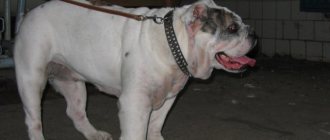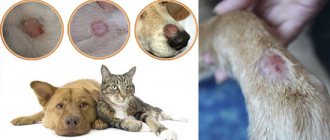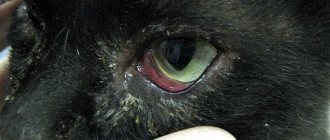Baralgin is a drug whose main components are metamizole sodium, macrogol and magnesium stearate. The most popular form of release is tablets; the drug is also available in injection ampoules and suppositories.
The medicine has an analgesic, anti-inflammatory and antipyretic effect. Most often used in the treatment of headaches, to relieve pain in the postoperative period, to relieve chronic pain.
Baralgin makes life easier for people, but can this medicine be used to treat animals, in particular dogs?
Ibuprofen: Why is it a Risk?
Painkillers are present in almost every home medicine cabinet. your use is widely used in humans and does not pose serious dangers. in dogs, however, they can be very dangerous and even lead to the death of the animal.
These products and their composition are intended for the human body. even at a low dose it can cause problems for dogs to come.
The toxicity of ibuprofen in dogs has been proven. handling a pet is a serious mistake that can cause great inconvenience. This is also a very common mistake.
Either because you have them on hand, because they are cheaper than pet painkillers, or to save a veterinary consultation, their use in dogs is very common.
Analogs
The pharmaceutical industry can offer us several more acceptable painkiller options. So, let's take a closer look at their main characteristics.
Vedaprofen (Quadrisol-5). This is an analgesic for dogs with a pronounced anti-inflammatory effect. Unlike Ketonal, the release form of this drug is only enteral (in the form of a gel), in special dispensing syringes.
In order for the dog to eat this drug without problems, aromatic fragrances are added to it, but no one can give a 100% guarantee that the dog will not become stubborn and eat it. Dosage – 0.5 mg per 1 kg of dog weight. It is recommended to take no more than one month.
Carprofen (Rimadyl). It is quite a strong analgesic, perhaps it is not inferior in effectiveness to Ketonal, but the price is several times higher. In addition to the analgesic effect, the medicine relieves swelling and helps reduce temperature.
Carprofen is often given after major surgery. Dosage – 0.2-0.4 mg per day per 1 kg of live weight. The course of treatment is often unlimited, but should be given with extreme caution to animals with liver or kidney disease.
In addition, like Ketonal, Carprofen is not prescribed to puppies under three weeks of age and Labrador dogs due to special sensitivity.
Baralgin (Analgin). It is a classic pain reliever. The dosage of baralgin is approximately 0.1 ml of solution intramuscularly per 1 kg of pet weight.
It is prescribed if it is necessary to quickly relieve the animal of sharp and severe pain (fracture, torn ligaments).
Unlike Ketonal, Baralgin has a short-term analgesic effect, so a repeat injection will be required after a few hours. It is suitable for puppies up to six months and dogs weighing less than 3 kg.
For children, the dose is 1/4 tablet. For tailed animals weighing from 3 to 5 kg - 1\2, and for larger animals - 1 tablet. However, you should not abuse it; it is recommended to give it a maximum of twice a day. Long-term use has a detrimental effect on hematopoiesis.
What you need to know about ibuprofen toxicity in dogs?
Unfortunately, intoxication with this drug, along with paracetamol and aspirin, is one of the most common poisonings. An estimated one in three give these medications to their pets.
The animal's body is very different from the human body , as well as the effect that the medicine has. There are certain enzymes in the body that attack drugs. In animals, these enzymes differ, as well as the form in which pharmacological substances are destroyed. This means that many of these substances are not broken down and remain in the dog's body and therefore lead to poisoning.
What happens then? The animal's body is not suitable for receiving and processing this type of medicine. His Body does not eliminate toxic substances.
This explains the cause of ibuprofen toxicity in dogs.
Instructions for use
In tablets or injections?
Baralgin is available in the form of injection ampoules and tablets with a pronounced green color. Intramuscular injections are more suitable for dogs - this way the medicine is better absorbed and will help the animal faster.
If there are no ampoules at hand, you can use tablets, but in this case the medicine may take too long to be absorbed from the gastrointestinal tract. In addition, when treating small breed dogs, injections are preferable, because the tablet will have to be divided into several parts.
Approximate dosage
Baralgin tablets are injected forcibly under the root of the tongue. Injections are administered at the rate of 0.05 mg per kilogram of animal weight. The dosage should not exceed 0.08 ml of solution to avoid side effects. Thus, an animal weighing ten kilograms should be administered no more than a milliliter of Baralgin.
In situations where it is impossible to give an injection, tablets are suitable. For a dog weighing 10 kilograms, a quarter of a whole pill will be enough.
How do they inject?
A suitable site for intramuscular injection is the thigh area. In this case, several rules should be followed:
- Before the injection, you need to calm the dog and massage the injection area: the animal’s muscle should be relaxed.
- There is no need to treat the injection site with alcohol.
- Do not touch the needle with your hands - you can get an infection!
- The drug should not be too cold or too hot, the ideal temperature is 37 degrees.
- The needle must be inserted at a right angle, slightly deeper than halfway. Try to immediately place your hands correctly so that you don’t have to change their position later - this will cause unnecessary discomfort to the dog.
Difficulties may arise with an intramuscular injection. If something is blocking the needle's progress, it may have already gone too far.
If blood appears at the puncture site, the needle has damaged the vessel. You need to remove the needle, treat the injection site and remove the blood. In this case, the injection must be given in another place.
If the needle hits a nerve, the animal may limp. A hematoma may occur, then applying an iodine mesh will help.
The speed of drug infusion is important. The more medicine needs to be administered, the slower it should be done. It takes approximately one second to administer 0.5 ml of medication.
Remember that the animal senses your emotions, especially fear and panic. You need to act confidently, without hesitation. The longer a person prepares to carry out the procedure, the greater the animal’s excitement.
Is there a risk-free dose?
Regardless of the dose administered, ibuprofen toxicity is always present in dogs.
ibuprofen has a small safety margin in dogs. For example, half a tablet is administered to a 50 kg dog, which already poses a risk. This may lead to poisoning. Stomach ulcers, kidney or heart problems may occur. There is also a risk of nervous system changes such as seizures or coma.
the consequences also depend on the size of the animal and sometimes even one dose is fatal for small dogs.
Rimadyl for dogs
The human drug Ketanov is used in veterinary medicine as an analgesic in the postoperative period, often in combination with other drugs (analgin, demidrol) or to relieve acute pain from injuries, tumor diseases, anesthesia.
This drug has side properties that are characteristic of all NSAIDs: it reduces blood clotting; disrupts the filtration function of the kidneys; promotes the development of gastritis, stomach and intestinal ulcers; causes stomach and intestinal bleeding. Clinically, side effects are manifested: vomiting, which increases; dehydration; anemia; black, pasty stools (melena); The vomit has a dark brown, dark color (“coffee grounds”) due to the blood digested in it. It is the resulting bleeding of the digestive organs that can become fatal for the animal, so it is used strictly according to the instructions of a doctor or in his presence. If the above signs appear, the dog needs urgent medical attention.
It is used in the following dosages: 2 mg/kg before the use of anesthesia, for painful manipulations; ketanov 0.4 ml + analgin 50% 0.5 ml + 0.2 ml diphenhydramine per 10 kg of body weight in the postoperative period in combination with small doses of ranitidine to prevent peptic ulcers.
Ketanov is used only in the form of injections; taking it in tablet form is prohibited. The course of treatment and dose of the drug is determined by the doctor, but it should not exceed 4 days. This drug is prescribed and used rarely when there are no other options.
Symptoms of poisoning
When a pet has taken ibuprofen, the following symptoms indicate possible poisoning:
- powerlessness
- frivolity
- nausea and vomiting
- stomach cramps
- diarrhea
- black chair
- renal failure
Composition and action
The active ingredient of the drug is ketoprofen. This is a non-steroidal anti-inflammatory drug that has:
- anti-inflammatory;
- antipyretic;
- analgesic effects.
Ketoprofen quickly relieves pain syndromes of various origins and is effectively used in the treatment of joint diseases and as first aid for injuries.
Of all the non-steroidal anti-inflammatory drugs that are developed for the treatment of humans, Ketonal is better tolerated, therefore it is used more often than other analgesics in veterinary medicine. The active substance reaches its maximum concentration in the blood within 15-30 minutes after taking the medicine, the therapeutic effect lasts for 6-8 hours. The drug is not addictive and can be used to treat acute and chronic inflammatory diseases.
Adviсe
In conclusion, these useful recommendations:
- Never give your pet medications intended for human use, even if it is a seemingly small dose.
- save Medicines are out of the dog's reach.
- For any illness, consult a veterinarian. The expert will determine the medication suitable for the animal, the appropriate dose and time of administration. If this is a familiar expert, even a simple call is enough.
- If any of the symptoms occur, contact your veterinarian immediately so that appropriate measures can be taken.
Medicinal properties indications for use
Pain relief is considered standard situations for treating four-legged pets:
- after surgical interventions, including castration;
- for colic (renal, intestinal and biliary) caused by spasm of smooth muscles;
- severe fever due to infectious diseases;
- damage to the movement apparatus (arthritis);
- diseases of the spine and damage to peripheral nerves (osteochondrosis, neuritis)
You can administer the drug to an animal for some injuries, if it is not possible to quickly get it to a doctor.
Antibiotics and antiseptics for dogs
Antibiotics for dogs must be in your first aid kit - this is Sinulox (tablets or injection bottle); tsiprolet (tablets); cefazolin, cloforan or ampiox (dosage: 1 g of antibiotic diluted with 4 ml of novocaine or saline; injected 2 times a day; single dose per dog - 0.5-1 ml).
Antiseptics for dogs are also necessary: brilliant green, or brilliant green (1% alcohol solution); iodine (5% solution; lubricating the skin or wound edges); crystalline potassium permanganate, or potassium permanganate; chlorhexidine (for treating the surface of wounds); hydrogen peroxide (3% solution; best stored in the refrigerator).











